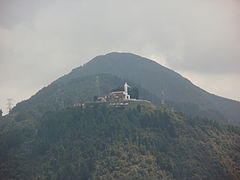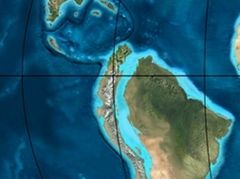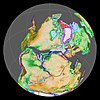Guadalupe Group
| Guadalupe Group | |
|---|---|
| Stratigraphic range: Campanian-Maastrichtian ~ | |
 Guadalupe Hill Type locality of the Guadalupe Group | |
| Type | Geological group |
| Sub-units | Arenisca Labor-Tierna Plaeners Arenisca Dura |
| Underlies | Guaduas Formation |
| Overlies | Villeta Group Conejo Fm. & Chipaque Fm. |
| Lithology | |
| Primary | Sandstone, shale |
| Other | Salt (allochtonous) |
| Location | |
| Coordinates | 4°35′31″N 74°03′15″W / 4.59194°N 74.05417°W |
| Region | Altiplano Cundiboyacense Eastern Ranges, Andes |
| Country | |
| Type section | |
| Named for | Guadalupe Hill |
| Named by | Pérez & Salazar |
| Year defined | 1978 |
| Coordinates | 4°35′31″N 74°03′15″W / 4.59194°N 74.05417°W |
| Region | Cundinamarca, Boyacá |
| Country | |
| Thickness at type section | 750 metres (2,460 ft) |
 Paleogeography of Northern South America 65 Ma, by Ron Blakey | |
The Guadalupe Group (Spanish: Grupo Guadalupe, K2G, Ksg) is a geological group of the Altiplano Cundiboyacense, Eastern Ranges of the Colombian Andes. The group, a sequence of shales and sandstones, is subdivided into three formations; Arenisca Dura, Plaeners and Arenisca Labor-Tierna, and dates to the Late Cretaceous period; Campanian-Maastrichtian epochs and at its type section has a thickness of 750 metres (2,460 ft).
Etymology
The group was published in 1978 by Pérez and Salazar and named after its type locality Guadalupe Hill in the Eastern Hills of Bogotá.[1]
Description
Lithologies
The Guadalupe Group is characterised by three formations; two sandstone sequences, Arenisca Dura and Arenisca Labor-Tierna, and an intermediate shale formation; Plaeners.[1]
Stratigraphy and depositional environment
The Guadalupe Group overlies the Conejo Formation in the central part of the Altiplano Cundiboyacense and the Chipaque Formation in the eastern part and is overlain by the Guaduas Formation. Some authors define the Guadalupe Group as a formation and call the individual formations members.[2] The thickness of the Guadalupe Group in its type locality Guadalupe Hill and the El Cable Hill is 750 metres (2,460 ft).[3] The age has been estimated to be Campanian-Maastrichtian.[4] The Guadalupe Group has been deposited in a marine environment.[5]
Outcrops
The formations of the Guadalupe Group are apart from its type locality at Guadalupe Hill, Bogotá, found in other parts of the Eastern Hills of Bogotá, the Ocetá Páramo and many other locations, such as the Piedras del Tunjo in the Eastern Ranges.[4][6]
At present, the Guadalupe Group in the anticlinals of Zipaquirá and Nemocón contains rock salt. These halite deposits are not originally deposited in the Late Cretaceous Guadalupe Group, yet are allochthonous diapirs formed when the Jurassic-Lower Cretaceous normal faults were reactivated as reverse faults during the mayor Miocene tectonic movements of the Eastern Ranges.[7] The salt had been deposited during the Early Cretaceous (Valanginian-Barremian, approximately 135 to 125 Ma),[8] intruding into the overlying formations of the Upper Cretaceous.[9]
Regional correlations
- Legend
- group
- important formation
- fossiliferous formation
- minor formation
- (age in Ma)
- proximal Llanos (Medina)[note 1]
- distal Llanos (Saltarin 1A well)[note 2]
Panorama
See also
Notes
References
- ^ a b Montoya Arenas & Reyes Torres, 2005, p.37
- ^ Guerrero Uscátegui, 1992, p.4
- ^ Guerrero Uscátegui, 1992, p.5
- ^ a b Montoya Arenas & Reyes Torres, 2005, pp.38-50
- ^ Villamil, 2012, p.164
- ^ Plancha 227, 1998
- ^ Montoya Arenas & Reyes Torres, 2005, p.98
- ^ Guerrero Uscátegui, 1993, p.12
- ^ García & Jiménez, 2016, p.24
- ^ a b c d e f García González et al., 2009, p.27
- ^ a b c d e f García González et al., 2009, p.50
- ^ a b García González et al., 2009, p.85
- ^ a b c d e f g h i j Barrero et al., 2007, p.60
- ^ a b c d e f g h Barrero et al., 2007, p.58
- ^ Plancha 111, 2001, p.29
- ^ a b Plancha 177, 2015, p.39
- ^ a b Plancha 111, 2001, p.26
- ^ Plancha 111, 2001, p.24
- ^ Plancha 111, 2001, p.23
- ^ a b Pulido & Gómez, 2001, p.32
- ^ Pulido & Gómez, 2001, p.30
- ^ a b Pulido & Gómez, 2001, pp.21-26
- ^ Pulido & Gómez, 2001, p.28
- ^ Correa Martínez et al., 2019, p.49
- ^ Plancha 303, 2002, p.27
- ^ Terraza et al., 2008, p.22
- ^ Plancha 229, 2015, pp.46-55
- ^ Plancha 303, 2002, p.26
- ^ Moreno Sánchez et al., 2009, p.53
- ^ Mantilla Figueroa et al., 2015, p.43
- ^ Manosalva Sánchez et al., 2017, p.84
- ^ a b Plancha 303, 2002, p.24
- ^ a b Mantilla Figueroa et al., 2015, p.42
- ^ Arango Mejía et al., 2012, p.25
- ^ Plancha 350, 2011, p.49
- ^ Pulido & Gómez, 2001, pp.17-21
- ^ Plancha 111, 2001, p.13
- ^ Plancha 303, 2002, p.23
- ^ Plancha 348, 2015, p.38
- ^ Planchas 367-414, 2003, p.35
- ^ Toro Toro et al., 2014, p.22
- ^ Plancha 303, 2002, p.21
- ^ a b c d Bonilla et al., 2016, p.19
- ^ Gómez Tapias et al., 2015, p.209
- ^ a b Bonilla et al., 2016, p.22
- ^ a b Duarte et al., 2019
- ^ García González et al., 2009
- ^ Pulido & Gómez, 2001
- ^ García González et al., 2009, p.60
Bibliography
- Template:Cite LSA
- Template:Cite LSA
- Template:Cite LSA
- Template:Cite LSA
- Template:Cite LSA
- Template:Cite LSA
Maps
- Template:Cite LSA
- Template:Cite LSA
- Template:Cite LSA
- Template:Cite LSA
- Template:Cite LSA
- Template:Cite LSA
- Template:Cite LSA
- Template:Cite LSA
- Template:Cite LSA
- Template:Cite LSA
- Template:Cite LSA
- Template:Cite LSA
- Template:Cite LSA
- Template:Cite LSA
- Template:Cite LSA
- Template:Cite LSA
- Template:Cite LSA
- Template:Cite LSA
External links
- Geologic groups of South America
- Geologic formations of Colombia
- Cretaceous Colombia
- Upper Cretaceous Series of South America
- Campanian Stage
- Maastrichtian Stage of South America
- Sandstone formations
- Shale formations
- Shallow marine deposits
- Reservoir rock formations
- Altiplano Cundiboyacense
- Geography of Cundinamarca Department
- Geography of Bogotá



























